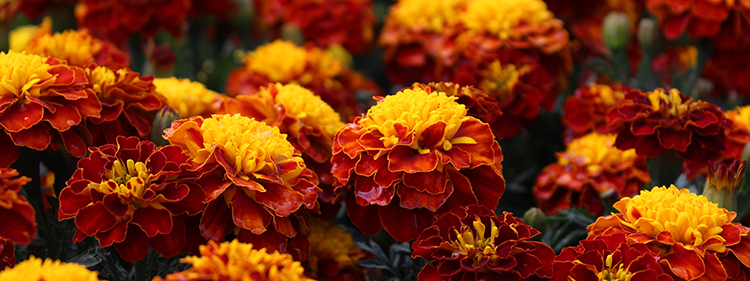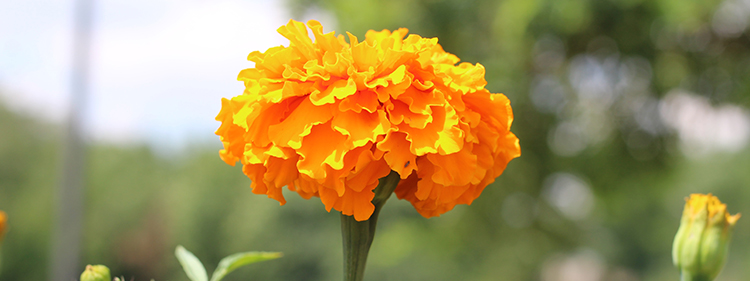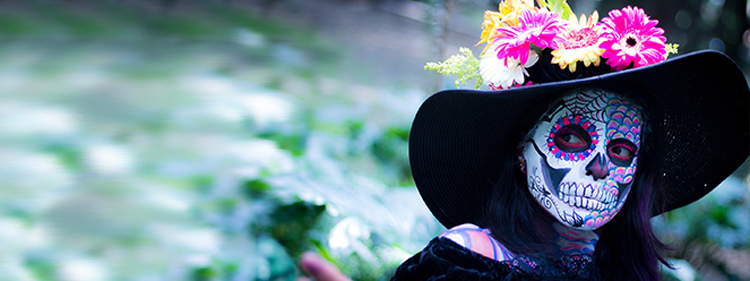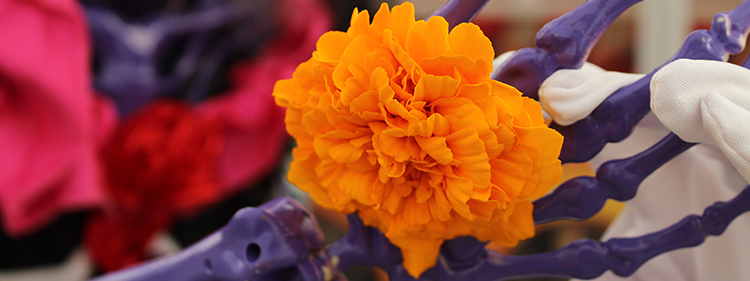Over the last few years, the Day of the Dead or el Dia de los Muertos has gained popularity across the world. Animated movies like Coco and The Book of Life have opened the global audience to this gothic yet colourful Mexican holiday. While the beautifully decorated skulls and paper butterflies contribute to the stunning imagery of the festival, marigold flower is also among the icons that remain unforgettable.
Now, you might wonder why marigolds are significant in the Day of the Dead festival. Do they only serve aesthetic purposes? We’ll explore everything you need to know about these vibrant flowers and their importance in the Aztec and modern Mexican cultures. You’ll also learn how marigolds can become staple blooms in your garden.

What Is the Day of the Dead Festival?
Every year, from October 31 to November 2, Hispanic families celebrate el Dia de los Muertos or the Day of the Dead festival. A blend of Spanish culture, Mesoamerican ritual, and European religion, this tradition is believed to welcome back the souls of deceased loved ones. The Day of the Dead gives families a brief reunion that includes drinks, food, and celebration.
In Mexico, las offrendas or offerings are set up on altars in homes to welcome the souls of dead relatives. These altars are decorated with marigold flowers; incense; traditional dishes like tortillas, tamales, mole, and pumpkins; toys; and personal effects. In some cases, families create a path of marigold petals to guide the souls of their loved ones to their home altars.
What Is the Meaning Behind the Marigold Flower?
Now, you might wonder why marigold flowers are widely used in the Day of the Dead festival. Well, its origin can be traced back to indigenous Aztecs—long before European colonialists set foot on the American continent. Spanish conquistadores created an account about Mexican herbal medicines in the 1552 book, “De la Cruz-Badiano Aztec Herbal.”
They learned that natives in Mexico used marigold flowers as a remedy for hiccups and the effects of a lightning strike. Early Aztecs also used the flowers to help individuals cross a body of water safely. They believed that there were healing and magical properties in marigolds. This is probably the reason why the flower is part of the rituals and traditions on the Day of the Dead festival.

Offerings on Dia de los Muertos Altars and Marigold Flowers
The offerings on the altars during the Day of the Dead festival primarily serve to remember the departed. They also symbolise eternal life and the belief that the presence of a loved one is everlasting. In a way, the offerings express the family’s affection toward their departed relatives. Below are some of the common items you’ll see on a Dia de los Muertos altar:
Dia de los Muertos altar items:
- Crop – This represents the earth and how the aroma of the harvest feeds the visiting souls.
- Papel Picado – This paper cut-out represents the wind. They are made by cutting elaborate designs into sheets of tissue paper.
- Water – The altar also has a container of water to quench the thirst of the souls after their long journey home.
- Wax Candles – These symbolise fire. Every lit candle represents a departed loved one. An extra one is added to the altar for the forgotten soul.
- Salt – Salt is also placed on the altar to represent purification.
- Incense or Copal – The aroma guides the souls through their journey and leads them back to their loved ones.
- Marigold flowers – Of course, the Day of the Dead festival won’t be complete with petals of marigolds creating a path towards the altar.
- Rug or Mat – These are placed at the foot of the altar to provide a place to rest for the souls after their long journey.
- Butterflies – The sheets of tissue paper can also be cut into butterflies to represent the belief that their loved ones can visit them any time. Some areas in Mexico believe that souls return to earth as a butterfly to check on their relatives.
As we’ve mentioned, the Day of the Dead festival is believed to welcome the spirits of departed loved ones. With the flower’s overpowering musky smell and vibrant colour, the souls easily find the altars that their relatives prepared for them. In a way, this celebration allows people to stay “in touch” with their departed loved ones. It can also be helpful in the process of grieving.
Tradition
By tradition, the altars are put together on the 30th and 31st of October. Then, they are taken down by the 2nd of November. People believe that the souls of deceased children return first. So, families lay the departed’s favourite toys and foods on the altar on the 31st of October.
By November 1, the spirits of the departed adults come. In anticipation of their visit, families set out spicy foods along with other delights like chocolates, nuts, fruits, and liquor. It is believed that the souls can only enjoy the aroma of the offerings. So, most of the time, the flowers, foods, and incense on the altar are incredibly aromatic.
What Are the Most Common Varieties of Marigold Flowers?
You probably discovered this article because you find the Day of the Dead festival interesting. You might also like to learn everything there is to know about the iconic marigold flower in the celebration. Well, you’re in luck because we’re going to share some important facts about this stunning perennial.
You’d be surprised to discover that marigolds are available in at least 50 species. However, only four varieties are commonly found in gardens:
African or Mexican Marigold
Scientific name: Tagetes erecta
Tagetes erecta is native to the Americas and it is the tallest variety of marigold flowers. It is usually planted in gardens and people expect it to grow 20 to 39 inches tall. Mexican or African marigold flower thrives in dry, hot conditions.
French Marigold Flower
Scientific name: Tagetes patula
Even though Tagetes patula is widely referred to as French marigold, it is native to Guatemala and Mexico. Compared to Tagetes erecta, French marigold flowers are more compact and smaller. Usually, this variant grows around 6 to 24 inches in height.
Golden Marigold or Signet
Scientific name: Tagetes tenuifolia
Golden marigold flowers have a different bloom than French and African marigolds. Growing 12 to 20 inches in height, tagetes tenuifolia has a compact and small floral head. This variant is popularly added to culinary dishes due to its lemony flavour. Its leaves also give off a citrus scent.
Poet’s or English Marigold
Scientific name: Calendula officinalis
This marigold species has vivid yellow and orange flowers. What’s more, it is known to tolerate cold temperatures. Its petals also have a citrus taste, making it one of the popular choices for edible flowers. It is commonly added to sandwiches, salads, and seafood dishes. English marigold flower usually grows 12 to 24 inches tall.

When Is the Best Time to Plant Marigold Flowers?
The upcoming Day of the Dead festival is not the only ideal time to plant marigolds. Depending on the species of flowers, you can grow these blooms throughout the year. For instance, you can plant young signet and French marigolds from spring through the middle of the summer season. Meanwhile, if you want tall African marigold flowers, plant them at the beginning of spring. They tend to mature and produce flowers more slowly.
Once you think that the soil is warmer and the danger of frost has passed, you can sow the seeds directly into your garden. You also have the option to let the seeds grow indoors. However, marigolds germinate so easily outdoors. So, there’s not much of a difference between the two options.
Now, if you want Mexican marigolds for the Day of the Dead festival, your best bet is to buy them as young plants. Otherwise, you should plant indoors about four to six weeks before the last frost date. Usually, in warm weather, you can expect marigolds to sprout within a week. Within eight weeks, the plants will begin producing blooms.
How Do You Plant Marigold Seeds Indoors?
If you want an early start for the growing season, you can plant your marigold seeds indoors. It’s usually more affordable to sow seeds than to purchase marigolds as young plants from a nursery. Besides, it’s more satisfying to see your marigold flowers mature from humble beginnings into garden beauties.
What You’ll Need:
- A soil-free potting mix that contains perlite, vermiculite, perlite, bark or coconut coir
- A growing tray or small plastic containers
- Small pots
- Plastic wrap
- Water
Six to eight weeks before the last frost date, you should begin planting your marigold seeds. Follow these steps to get started indoors:
- Take your growing trays or containers then fill them halfway with damp, soil-free potting mix.
- Use the plastic wrap to cover the trays or containers, then place them in a warm place. You don’t have to install special lighting.
- After three days, check if the seeds have begun germinating. Once you see the seedlings, move the trays to an indoor area where the sunlight can get to them for at least five hours a day.
- Once you see two sets of leaves on the seedlings, you can move the plants to their own pots. They need to stay indoors until you’re certain that the last frost has passed. Make sure that they still get at least five hours of sunlight a day.
- When the soil outside is warm enough, you can move the plants outdoors. Plant each of them one to three feet away from each other. The area should get sunlight throughout the day.

How Do You Plant Marigold Seeds Outdoors?
As long as the ground is warm enough, it is easy to germinate marigold seeds outdoors. Here’s what you need to prepare:
- Garden trowel
- Well-draining soil that is exposed to the sun all day long
- Water
- Optional – fertiliser that is ideal for the conditions of your soil
Here are the instructions:
- Dig a hole that’s at least six inches deep in the soil using your trowel. Make sure you remove any stone you see.
- If you’re planning to use fertiliser, put a bit of it into the hole. Fill the hole by an inch.
- Pour the water into the soil—just enough to dampen it.
- Sow the marigold seeds and make sure that they are at least an inch apart.
- Cover the seeds with a thin layer of soil.
How to Care for Your Marigolds
If you notice the top of the soil getting dry, you should give your marigolds a gentle watering. Keep in mind that these flowers hate soggy and overly wet soil. So, avoid overwatering, especially when your plants are in pots. Otherwise, your plants may develop root rot.
Once a month, you should feed your marigolds with liquid fertiliser according to the packaging directions. However, you should be careful because if you overfeed rich soil, it can weaken the marigolds. Also, if there are spent blooms, make sure to pinch them out. Doing so will keep the plants bushy and encourage them to keep flowering for as long as possible.
Usually, less is more when it comes to caring for marigolds. If you want to keep your marigold flowers healthy and happy, here are some simple care procedures you can do:
- In between waterings, you should let the soil dry out.
- Pour the water at the base of the marigold plant.
- It’s not necessary to deadhead, but if you choose to do so, the marigolds will keep producing flowers throughout the season.
- Lay down a layer of mulch between the plants to prevent weeds from growing.

Why Should You Grow Marigold Flowers?
The Day of the Dead festival is not the reason why marigold flowers are popular. You can have these bold, bright, and stunning blooms throughout the summer months and well into autumn. What’s more, they bring a host of advantages, including the following:
It increases aesthetic appeal
The vibrant colours will add life to your garden. Even when marigolds die after the first frost, their dried form can be great for those rustic floral arrangements that influencers love.
It’s easy to maintain
As you can see from our planting instructions, growing marigolds from seeds can be easy. Besides, they require simple care. Some species of this flower can survive even when you neglect them.
It repels mosquitoes
Because of the distinctive, pungent, and bitter scent of marigold flowers, they can drive mosquitoes away from your property. Marigold contains pyrethrin, which is also a common ingredient in plant-based insect repellents. A study published in the Iranian Journal of Arthropod-Borne Diseases reported that essential oil from the flower is as effective as DEET in repelling mosquitoes.
It supports the health of garden plants
Marigold flowers are not only great to look at on altars during the Day of the Dead festival. They also serve a practical purpose for your garden, especially since they can be great companion plants. These flowers can repel pests like roundworms and beetles. So, they also protect the health of other plants in your garden.
It saves the bees
As we’ve mentioned, marigolds naturally repel certain insects. Because you won’t need insecticide in your garden, the honeybees won’t be exposed to harmful pesticides. By planting marigold flowers, you are also protecting the bee population in the country.
It is edible
Wouldn’t it be fun to step into your garden and just pluck out flowers that you can add to your salads? Your sandwiches can get a unique, spicy tang from marigold petals. However, make sure you’re not using pesticides if you’re planning to eat the flowers. Also, it’s best that you sample the flowers to check for allergic reactions.

Other Flowers for the Day of the Dead Festival
Orange and yellow marigolds are among the most popular flowers used in the Day of the Dead festival. However, there are also other blooms tied to the celebration. Here are some of the flowers that bring other levels of meanings to this beautiful tradition:
Cockscomb
Cockscomb is usually used with marigolds in decorating altars for el Dia de los Muertos. The Mexican Folk Art Guide shares that the deep red colour of the flower represents the blood of Jesus. People also like to keep their altars bright with marigolds and cockscomb. Unlike in other cultures, the Day of the Dead festival is a happy and cheerful event.
Chrysanthemum
White chrysanthemums are common funeral flowers around the world, and they’re also used in the Day of the Dead altars. Similarly, white baby’s breath looks like clusters of clouds that provide an ethereal look in arrangements for this celebration.
Gladiolus
In many cultures, long-stalked gladioli represent faithfulness and remembrance. This is also the reason why these flowers are commonly found on tombstones and gravesites during the Day of the Dead festival. Usually, gladioli are used as part of a bouquet. They are often arranged with baby’s breath or other flowers associated with the celebration.
White Hoary Stock
Departed children are remembered during the festival through white hoary stock. The Mexican Folk Art Guide shares that this flower represents simplicity and beauty. While the hoary stock comes in various colours, white is used to memorialise children. In Mexican culture, white hoary stock also symbolises innocence.
Baby’s Breath
Baby’s breath signifies innocence, love and purity. During the celebration, these flowers are used as accents in crowns and floral arrangements for altars and gravesites.

FAQs About the Day of the Dead Festival
Q: What is the Day of the Dead?
Also known as el Dia de los Muertos, the Day of the Dead is an annual Mexican celebration. During this event, families gather to remember and honour deceased loved ones.
Q: What is the use of marigold flowers?
There are the many uses associated with marigold flowers:
- Decoration for the Day of the Dead altars
- Plant-based mosquito repellent
- Edible flowers for salads, sandwiches and other dishes
- Medicinal flower for addressing cuts and general skin care
Q: What is the meaning behind the marigold flower?
The meaning of the marigold flower varies, depending on the culture. However, because of its bright yellow or orange colour, it is often associated with the sun. In certain cultures, it is believed that the flower has the power to resurrect or guide spirits back to the world.
Q: How long does the Day of the Dead last?
Preparations begin from the last day of October, but the Day of the Dead festivities run from November 1 to 2.
Q: What does the Day of the Dead celebrate?
The Day of the Dead festival celebrates life and death. In Mexican culture, it is believed that the departed visit their living relatives during this time.
Get Vibrant Flowers Any Day of the Year
You don’t have to wait for the Day of the Dead festival to enjoy vibrant and stunning flowers. For any occasion, you can turn to Flowers Across Sydney and get the blooms you want. We’ve got gerberas in bright orange and yellow that are quite similar to the appeal that marigold flower brings. You can also find a wide selection of mums, sunflowers and lilies that can add meaning to your celebrations.
Turn to Flowers Across Sydney today to get stunning blooms for every occasion.



No Comments